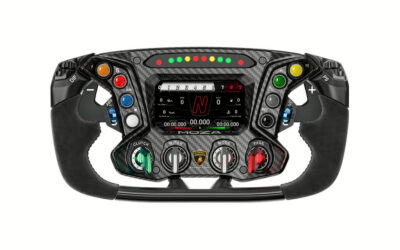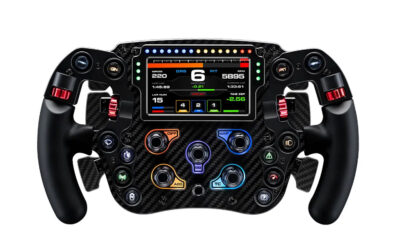MOZA VISION GS
Benefits
- Unique design with central display mounted on electronic gyroscope
- Premium materials
- GT-style steering wheel
Disadvantages
- Fairly high selling price
Our rating : 9.8/10
Moza Racing is determined to gain a greater share of the sim-racing and simulation market in general. After the launch of its truck driving simulation steering wheel, and its range of flight simulation peripherals, it’s now the turn of the new Vision GS to finally show its face to the general public.
This new wheel was announced 1 year ago, during the Gamescom in Cologne, Germany. Featuring a futuristic design, as well as unique functionalities, this steering wheel took the Chinese firm a year to unveil in its final version, and also marketed some time ago.
Combining a unique design, a distinctive shape and, above all, a standard-bearer for Moza product customization, the Vision GS is ready to titillate Fanatec‘s most premium steering wheels. Will it live up to its ambitions? That’s what we’re going to find out.
Main and technical features of the steering wheel
- GT-style wheel with aggressive rectangular shape
- 31 cm diameter
- Structure in aluminum alloy from the aeronautics industry
- Premium leather all around with black stitching
- 2.85-inch circular HD touchscreen
- 4 forged carbon fiber blades, 2 of which are magnetic
- 17 controls in all, including 8 backlit buttons
- Compatible with new Moza bases, as well as other bases via a hub
Design
Let’s start with the design of this all-new Vision GS. This steering wheel is, in my opinion, very much inspired by the one found in the Mercedes AMG One, you know, the hypercar that costs an arm and a leg and is more or less an F1 street legal.
The shape of the Vision GS is very rectangular, with lots of color on the front. All buttons on the front are backlit, and the centerpiece is the 2.85″ circular display. There’s also a carbon-fiber composite on the faceplate, which accentuates the racing look of the steering wheel. As far as I’m concerned, it’s beautiful, even if I’m not a big fan of the shape, as it limits its use to a few sim-racing disciplines, notably GT and F1.
Customized assembly
The Vision GS is assembled via the Moza Quick Release we all know, and more precisely its revised version. Based on the D1-Spec, this QR is also shared with Simagic, with a few modifications of course.
To mount the flywheel on a Moza base, or any other base if you have the universal hub kit, simply pull the ring, align the flywheel and insert it, then release the ring. The connection is very solid, allowing no flex on the drive shaft. This QR is one of the best available on the market today.
Manufacturing and finishing
The Vision GS is a very premium steering wheel from Moza, so it had to have top-of-the-range materials. Like virtually all Moza steering wheels, it features an aluminum alloy structure derived from the aerospace industry. The perimeter is covered in well-made leather, with hand-crafted black stitching, forged carbon fiber for the rear paddles, and a carbon fiber composite (coupled with plastic, of course) on the faceplate surrounding the circular display.
In terms of build quality, there’s absolutely nothing to say about the Vision GS. It’s very premium, with great attention to detail, and that’s only to be expected given that this wheel is the most expensive in Moza’s catalog. Well, for now.
Handling the steering wheel
So, when it comes to getting to grips with this steering wheel, you’ll be limited in what you can do. Its main focus is on GT and F1, and even endurance racing, even if the controls are missing from the faceplate. The diameter is 31 cm, which is quite comfortable to hold, and the driving position is 9H15, with the bottom handles closed.
All controls are easily reached from the steering wheel, without your hands leaving their position. Whether it’s the paddles, switches, buttons or even the touchscreen, everything is correctly positioned on the Vision GS, with thought behind it. What’s more, you’ve got a RevLED on the top of the steering wheel, which makes quick RPM readouts very easy to do on the fly.
Also, the rear-mounted paddles are very close to your fingers, as well as being quite large. The gearshift paddles are magnetic with a Hall sensor, rather standard in the segment, and the other two are analogous. The 2 magnetic ones click well, but make a lot of noise, as is the case with many other Moza steering wheels. As for the analog paddles, the spring is OK, but rather soft. But it’s fine for sim-racing use.
Sensations during play
For the feel, I paired the Vision GS with a Moza R16 to give me a good base on which to test this wheel. The biggest advantage of this wheel is its fully customizable, touch-sensitive screen, which doesn’t move when the wheel is turned. Physically, the screen is part of the faceplate, so it rotates with it. But the image displayed is fixed, and if you turn the wheel, you’ll always have the lap counter centered, for example.
In terms of handling, we’ve already seen that, and the Vision GS is excellent in this area. As for the screen, as I said, it’s entirely customizable via Moza’s software. You can display telemetry, the circuit, laps, time, tachometer, speedometer, and a whole host of other menus with your fingers. The screen is very responsive, in 60 Hz and above all HD. It’s not a slab where you’ll have trouble reading the information displayed on it if you’re far away from it.
What’s more, when racing, the screen is a major advantage over the competition, as you no longer need to buy a dashboard, and the image is centered too, not rotating with the steering wheel. It’s more or less the Lord of the Rings version, but for sim-racing steering wheels.
Compatibility
As far as bases are concerned, this steering wheel is compatible with all those offered by the Chinese brand. But where Moza has given us a little surprise is the wheel’s compatibility with other manufacturers’ bases. All you need is a universal hub – which isn’t expensive, by the way – and a USB connection to your PC, and you’re all set.
As far as platform compatibility is concerned, the Vision GS is PC-compatible only.
Value for money
The Vision GS sells for €830 in Europe, and $750 in the US, excluding tax. The price, for what you get in the end, is not bad I think. It’s not excessively expensive, as can be seen on some of Fanatec’s wheels(BMW M4 GT3 which, although magnificent, is worth €1,500, for example), especially as the build quality is truly premium.
My verdict
The Vision GS has proved to be a superb wheel for fans of GT and F1 racing. It’s a premium wheel, very well finished and using quality materials. What’s more, the screen is practical when racing, responsive and boasts excellent resolution.
If you can afford it, I’d recommend pairing this wheel with an R16 or any other chainstay developing between 12 and 15 nm of torque. The Vision GS isn’t light, although it’s not really heavy either, but you’re likely to get clipping with a small chainstay (R3 or R5, for example).
Admittedly, its shape limits its use to GT or F1, but there are fans who only like these races. In any case, it remains a superb wheel.












0 Comments